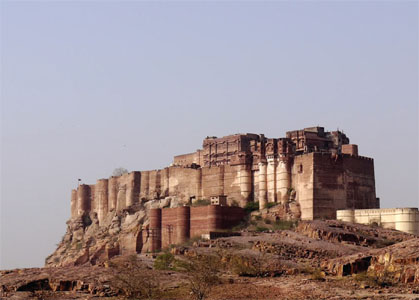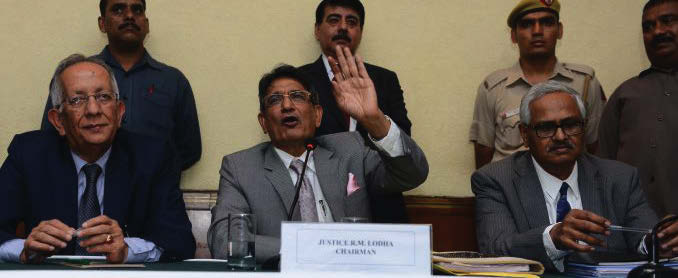
Colourful cityscape
The silky sand dunes of the Thar Desert dotted with camels basking in the sun, towering forts and palaces glistening in red sandstone and the narrow lanes leading to shops that open into an alluring world of handicrafts are some of the welcoming sights here. We were fortunate to have a host-cum-tour guide to walk us into different eras every time we stepped inside historical monuments, temples and gardens.
Madan Lal Jangid, a 69-year-old French professor, entrepreneur, researcher and an avid traveller could not be dismissed as one of those guides who takes tourism to be a revenue-making business. “I cannot wrap up the history of a place in 45 minutes, make money and let you go feeling satisfied. I remember when a diplomat from Canada had been here, we spent at least 4-5 hours in Mehrangarh Fort discussing the many stories behind every pillar and rock.
That is how you connect; summarising a history in stock-and trade terms is a fruitless exercise,” asserts he. Our car moved through the nooks and crannies of the city in a way that the seat’s window became a frame to the colourful images outside running past one after the other. From veiled women keeping up with their husbands’ pace, the paan wala sprinkling water on the cascading betel leaves, little boys encircling foreign tourists to that old woman under the shade of the Clock Tower with a heap of coloured shoelaces awaiting buyers; the transition seemed like we turn pages in a photo album.
The Royal quarters of Mehrangarh Fort
The mighty walls of the Mehrangarh Fort have many secrets buried inside. Maintained by the present generation of Marwar Kings, Maharaja Gaj Singh II, the expansive courtyards, exquisite palatial spaces like the Moti Mahal (Pearl Palace), Phool Mahal (Flower Palace), Sheesha Mahal (Mirror Palace), and hidden balconies for women to listen to court proceedings, chambers and galleries enrich the fort’s heritage. Our host informs us that this is the only fort where you will find the provision of an elevator allowing people to not worry about any physical barriers during their tour. There is yet another purpose of the elevator; it leads you to the Mehran Terrace, a roof-top restaurant where people take delight in indulging in the traditional Rajasthani thali.
And what better way to admire the beauty of a worldclass historical monument than sitting on the terrace beneath the twinkling stars and dim-lit candles on the dining table? On reaching the top floor, the view of the entire cityscape is breathtaking.
All the gates of the fort are visible and the panoramic view seems sketched on a blue canvas. Blue, because the cluster of buildings are bathed in that colour and there is a reason too. The colour was earlier identified with a certain privileged section of society, a marker of a higher caste but slowly as civilization grew, such social indicators ceased to have any significance. Subsequently, blue emerged as the universal colour of all communities irrespective of distinctions. Jodhpur is not only known as the ‘sun’ city, it is also referred to as the ‘blue’ city, like Jaipur is the Pink City.
Jaswant Thada
Located half way up the road that climbs onwards to the Mehrangarh fort is Jaswant Thada. Immaculate in white marble, this mausoleum was built in the year 1899 in the memory of Maharaja Jaswant Singh II. A tomb with an array of domes is the crematorium for Jodhpur rulers. As the sun rays kiss the milky surface of the monument, the memorial comes alive in a glaze and its intricate carved jalis (screens) emit a glow.
The grandeur of Umaid Bhavan
This palace was born out of a crisis. When consecutive seasons went without rain, a famine-like situation arose that threatened the economic lives of people. Maharaja Umaid Singh decided to construct a palace that would not only relieve employment worries but also remain a monument of symbolic value for years. A visionary and benevolent king succeeded in his famine-relief policy that provided employment to thousands for a period of almost two decades from 1929-44. Anecdotes are many when it comes to discussing the Umaid Bhavan (initially called Chittar Palace for it stood on the Chittar Hills). The Art Deco furniture and impeccable interiors were originally crafted by Maples of London but unfortunately all furnishings could not reach the Palace.
In the wake of World War II, the furniture-laden ship succumbed to a tragedy and was sunk by the Germans en route to India. Nothing could deter the Maharaja’s plans and in came a Polish artist and refugee from war-torn Europe, Stephen Norblin, who mended what was wrecked.
Familiar with the work of Art Deco connoisseurs, Norblin did not fail the King. As you look through the paintings (essentially inspired by the episodes of Ramayana), gaze at the artefacts ranging from antique clocks (some in the shape of railway locomotives and others in windmills) to ornate ceilings; you would be quick to notice a harmonious “blend of occidental symmetry and oriental texture,” in the words of our host. Umaid Bhavan has been divided into three sectionsone portion is dedicated to the museum and exhibition area, the other is converted into a hotel and the third segment is owned by the current family of the royals headed by Maharaja Gaj Singh II.
Clock Tower and marketplace
Rajasthan is a land that celebrates colour and what better way to explore it than doing the rounds of the market area on the Nayi Sadak with the huge Clock Tower in the backdrop. Once you take a left from the Nayi Sadak, you reach the inviting world of lac bangles sparkling in embedded mirror work and bold colours almost blinding you at first sight. A walk through the Lakhara Bazaar reminds you of Delhi’s Chandni Chowk where everybody is scuttling around but with a sense of purpose. With bandhej designs, tie-dye prints, ethnic footwear and all things jodhpuri, you are bound to go neck-deep in shopping. Amid all the chatter of the localites, bickering of buyers and sellers, frying of ‘mirchi’ vadas and mawa kachoris (chilli-infused snacks) Jodhpur brightens up in the evenings. Biting into one of the spicy vadas, our host shared a trivia, “Rajiv Gandhi loved the mirchi vadas here and would never leave the city after every visit without his share of the popular snack”.
Mandore Garden
Gardens are supposed to make you feel happy but I entered into the gates of the Mandore Garden with a heavy heart. It was once a prominent entry point to the Mehrangarh Fort but today stands like an ordinary gateway. Its walls embossed in palm prints continue to speak of the cruel ritual of sati (burning of wives in the funeral pyre of their dead husbands) rampant during the time. Once inside, between the crevices of lush green trees you can catch a glimpse of the Mandore temple that is believed to be named after Ravana’s wife, Mandodari. On one hand, while a woman is a symbol of divinity, she is also subjected to atrocities like sati and dowry deaths; a conundrum unresolved.





Be the first to comment